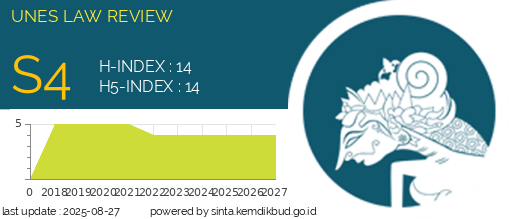Analisis Terhadap Alasan Memperingan dalam Putusan Mahkamah Agung Nomor 3287 K/PID.SUS/2019
DOI:
https://doi.org/10.31933/unesrev.v6i2.1427Keywords:
Reasons for Mitigating, Judge's Legal Considerations, Ratio DecidendiAbstract
Enforcement of criminal law at the examination stage in court hearings plays a crucial role in SPP. The court decision is the end of this stage. The heart of a court decision is the judge's legal considerations and ruling. The judge's legal considerations explain why his decision was such. One thing that is often included in the judge's legal considerations is the reason for mitigation which is the cause of the judge's decision regarding the sentence being reduced. In practice, the judge's legal considerations and rulings are not always in line with the Supreme Court's cassation decision Number 3287 K/Pid.Sus/2019. The type of research in this writing uses normative legal research, a type of secondary data with a library research method which is then analyzed using qualitative methods and drawing conclusions deductively. The reasons for mitigation in the court's decision are manifested in the judge's legal considerations. For reasons of mitigation, the judge handed down a lighter sentence to the defendant. The verdict, which carries a lighter sentence, is given by the panel of judges by including the reasons for mitigation in the legal considerations so that the Ratio Decidendi is created, and the decision can be justified. Article 95 of the Juvenile Criminal Justice System Law states that judges who make mistakes in deciding cases can receive punishment in the form of administrative sanctions in accordance with statutory provisions. In practice, in the Supreme Court's cassation decision Number 3287 K/Pid.Sus/2019, the panel of judges gave a lighter sentence decision than the public prosecutor demanded but did not explain the reasons for mitigation in their legal considerations, on the contrary what was explained was the reasons for aggravation, even though this is required in Law on Judicial Power to judges. Thus, the decision is contrary to the law, materially flawed and cannot be held accountable by the panel of judges because it does not present the Ratio Decidendi which is the mandate of Article 8 paragraph (2) of the Judicial Power Law that in considering the severity and severity of the crime, the judge must be obliged to clearly see the nature of the crime. good and bad of a defendant.
Downloads
References
Diantha, I Made Pasek. (2017). Metodologi Hukum Normatif dalam Justifikasi Teori Hukum. Jakarta: Prenada Media Group.
Efendi, Jonaedi. (2018). Rekontruksi Dasar Pertimbangan Hukum Hakim. Depok: Prenada Media Grup.
Fajar, Mukti. (2010). Dualisme Penelitian Hukum: Normatif dan Empiris. Yogyakarta: Pustaka Pelajar.
Shidarta. (2013). Hukum Penalaran dan Penalaran Hukum. Yogyakarta: Genta Publishing.
Soekanto, Soerjono. (2019). Pengantar Penelitian Hukum. Cetakan ke3. Jakarta: UI Press.
Soekanto, Soerjono & Sri Mamudji. (2001). Penelitian Hukum Normatif. Jakarta: Raja Grafindo Persada.
Hessick, Carissa Byrne. (2008). Why Are Only Bad Acts Good Sentencing Factors?. Boston University Law Review 88 (1109).
Hanata, Dwi. (2018). Pertimbangan Keadaan-Keadaan Meringankan dan Memebratkan dalam Penjatuhan Putusan Pidana: Aggraviting and Mitigating Circumstances Consideration on Sentencing. Jurnal Hukum dan Peradilan 7 (1).
Oetari, Adinda Anisa Putri & Ade Mahmud. (2021). Kebebasan Hakim dalam Penjatuhan Pidana terhadap Pelaku Tindak Pidana Korupsi Bantuan Sosial Covid-19 Dikaitkan dengan Asas Keadilan dan Dasar Pemberatan Penyalahgunaan Kewenangan. Jorunal Riset Ilmu Hukum 1 (2).
Wijaya, Endra. (2010). Peranan Putusan Pengadilan dalam Program Deradikalisasi di Indonesia. Jurnal Yustisia III (2).
Wijayanta, & Hery Firmansyah. (2013). Perbedaan Pendapat dalam Putusan Pengadilan. Yogyakarta: Medpress Digital.
Wijayanti, Tata & Sandra Dini. (2014). Disparitas Putusan Perkara. Jurnal Yudisial 1 (2).
Wilson, Jeski & Dian Adriawan DG Tawang. (2020). Analisis Pertimbangan Hakim dalam Memutuskan Perkara. Jurnal Hukum Adigama 3 (1).
Indonesia. Undang-Undang Dasar Negara Republik Indonesia Tahun 1945
Indonesia. Undang-Undang Republik Indonesia Nomor 8 Tahun 1981 tentang Hukum Acara Pidana.
Indonesia. Undang-Undang Republik IndonesiaNomor 19 Tahun 2016 tentang Perubahan atas Undang-Undang Nomor 11 Tahun 2008 tentang Informasi dan Transaksi Elektronik.
Indonesia. Undang-Undang Republik Indonesia Nomor 48 Tahun 2009 tentang Kekuasaan Kehakiman.
Downloads
Published
How to Cite
Issue
Section
License
Hak cipta :
Penulis yang mempublikasikan manuskripnya di jurnal ini menyetujui ketentuan berikut:
- Hak cipta pada setiap artikel adalah milik penulis.
- Penulis mengakui bahwa UNES Law Review berhak menjadi yang pertama menerbitkan dengan lisensi Creative Commons Attribution 4.0 International (Attribution 4.0 International CC BY 4.0) .
- Penulis dapat mengirimkan artikel secara terpisah, mengatur distribusi non-eksklusif manuskrip yang telah diterbitkan dalam jurnal ini ke versi lain (misalnya, dikirim ke repositori institusi penulis, publikasi ke dalam buku, dll.), dengan mengakui bahwa manuskrip telah diterbitkan pertama kali di Jurnal UNES Law Review.


















